According to a story from pharmavoice.com, a new partnership between the biotechnology company Vitrisa Therapeutics and the Foundation Fighting Blindness Clinical Research Institute (FFB-CRI) is in the works in order to design, test, and hopefully implement new clinical trials for Stargardt disease treatments.
Stargardt disease is an inherited disease of the retina, the inner layer of the eye that is sensitive to light. The illness causes macular degeneration, which can begin at different times in the patient’s life. In the most severe cases, degeneration can begin in childhood or adolescence, and eventually lead to progressive vision loss. The center of the visual field is most heavily affected; symptoms include blurred vision, impaired color vision, wavy vision, blind spots, loss of depth perception, and poor night vision. Symptoms cannot be corrected with glasses. The pace of vision loss and the symptoms experienced vary from person to person. While there are some lifestyle changes that may slow the progression of Stargardt disease, there is currently no available treatment. Most patients will eventually become legally blind. To learn more about Stargardt disease, click here.
FFB-CRI previously conducted a natural history study of Stargardt disease. The study, called ProgStar, is the largest natural history study for the disease that has ever been conducted. The organization has agreed to provide data from the study to Vitrisa. With this data, the company will test innovative new clinical trial designs. By testing these ‘virtual clinical trials’ the company will be able to see if new designs work more effectively than conventional clinical trial studies.
Clinical trial design has long been a subject of debate in developing treatments for rare diseases. Traditional trial designs can be exclusionary to many patients, and some studies suggest that changes to the manner in which trials are conducted could make them more efficient and scientifically valuable.
Approximately 30,000 people in the U.S. are affected by Stargardt disease, and the majority of them will eventually experience legal blindness. Hopefully, this new partnership will encourage the development of treatments for this illness, as Stargardt disease is a currently unmet medical need with no approved treatments.








